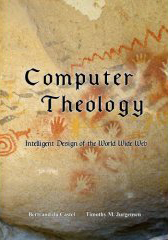PRESS
COMPUTER THEOLOGY |
||||
|
is, they must be properly provisioned. Once
provisioned, these particular variants of memory are indistinguishable from the
procedural elements of a program. The memory is just a means of direct support
for the procedural code. Context is established by the procedural code and the
contents of memory may have no meaning outside of this context. When technology
advanced to the point of providing extensive external computer memory in the
form of disk drives and magnetic tapes, the facilities for representing and
accessing large volumes of information continued apace. Initially, it became
possible to construct sets or tables of information, each perhaps establishing
a distinct context for execution within the stored program, and to maintain
these tables in external memory; that is, in files on disk drives. This, we
suggest, is qualitatively similar to episodic memory. Tables stored in files
correlate well to the memories of specific episodes of state transitions within
the stored program. Continuing the
progression toward more cognition aware forms of computer memory, we come to
databases. These facilities can store large volumes of information in a form
that allows for a variety of contexts to be established after the information
is actually stored. In particular, databases invite the creation of data models
that provide a definition of relationships among individual pieces of
information. This allows us, through the mechanism of the data model, to
extract the details of a context that the stored program may not have actually
encountered. This seems qualitatively akin to the concept of mimesis within the
mind of a human. Thus far, in our
considerations any stimulus response to stored information is completely
effected through the procedural code of the stored program. Context may be
established according to stored information, but motor responses are a generic
facility of the program. Throughout the course of this book, we have noted a
number of times the development of object-oriented mechanisms within computer
systems. Such mechanisms offer the early meanderings toward the metaphoric
comprehension of the human mind. In computer parlance, objects entail the
hiding of information behind a set of methods that may be invoked on or through
a particular object. Objects typically encompass a set of methods through which
they are created, provisioned with information, stimulated to evoke some
response based on that information and potentially destroyed when their utility
is at an end. Such mechanisms have qualitatively similar characteristics to
mythic comprehension. A single object may well entail a complete spectrum from
the causality of its creation, through its provisioning and on to its
subsequent use to evoke context-guided responses to sensory (information)
input. It is provided sensory input, but there is no way to look inside the
object to see how that sensory information is interpreted or stored. Moreover,
objects offer the prospect of extracting aspects of comprehension that can be
applied to other contexts. At the current apex of computer memory facilities are knowledge bases. These are constructs comprised of collections of distinct objects that can influence each other’s form and function. It is in this arena that the application of ontologies becomes particularly applicable. In this guise, an ontology becomes something of a metaphoric data model encompassing information, actions and interactions. Consequently, we perceive knowledge bases as qualitatively related to the theoretic memory suggested by Donald. They offer the prospect of guiding their own provisioning. Indeed, knowledge bases often comprise the central element of data warehousing and data mining operations. Within a knowledge base, when objects are constructed with a facility for reasoning about the form and function of other objects, then we conceptually see the earliest stages of independent cognitive behavior. From such endeavors, one finds systems that can systematically seek out context, that is information and actions intertwined, that offers at least some flavor of the |
||||
|
||||
© Midori Press, LLC, 2008. All rights reserved for all countries. (Inquiries) The contents of ComputerTheology: Intelligent Design of the World Wide Web are presented for the sole purpose of on-line reading to allow the reader to determine whether to purchase the book. Reproduction and other derivative works are expressly forbidden without the written consent of Midori Press. Legal deposit with the US Library of Congress 1-33735636, 2007.
|
ComputerTheology Intelligent Design of the World Wide Web Bertrand du Castel and Timothy M. Jurgensen Midori Press, Austin Texas 1st Edition 2008 (468 pp) ISBN 0-9801821-1-5 |
Book available at Midori Press (regular) |
